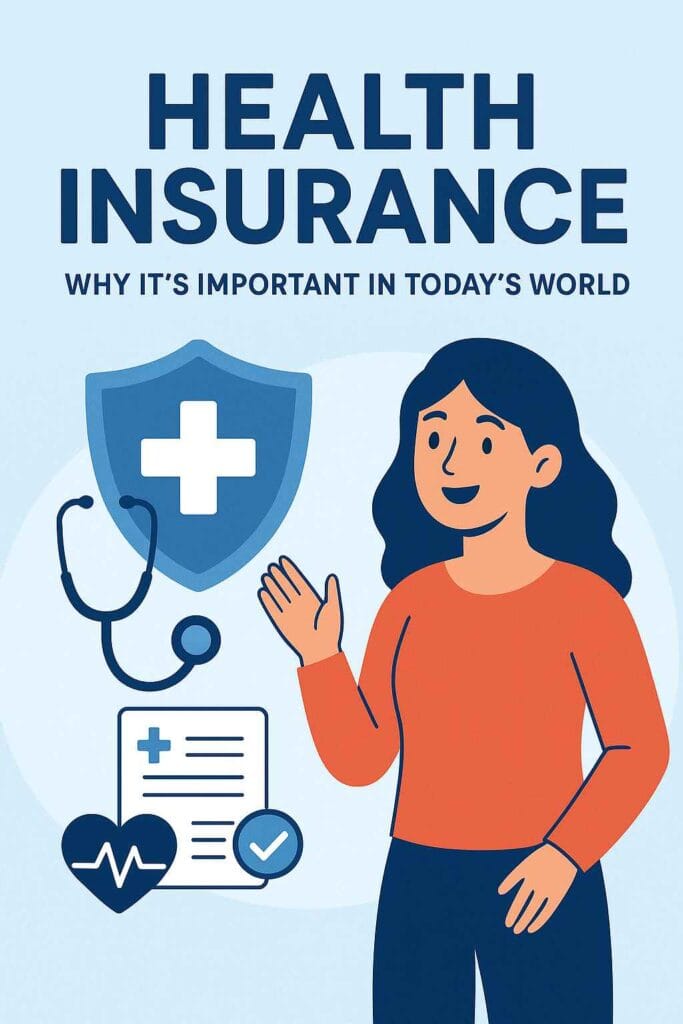Understanding Health Insurance: Your Friendly Guide to Staying Protected Worldwide
Hey there! Imagine this: You’re on a dream vacation in Thailand, sipping coconut water on the beach, when suddenly—bam!—you slip on a wet rock and end up with a sprained ankle. Ouch, right? Now, without health insurance, that quick trip to the local clinic could turn into a nightmare bill that wipes out your savings. But with the right coverage? It’s just a minor hiccup, handled smoothly. That’s why health insurance matters so much in today’s fast-paced, unpredictable world. Whether you’re jet-setting across continents, raising a family, or just navigating everyday life, having a safety net for your health can mean the difference between stress and serenity. In this post, we’ll chat about everything you need to know about health insurance—like I’m explaining it over coffee. We’ll keep it simple, fun, and real, with some tips, myths busted, and even a peek into the future. Let’s dive in!
What Is Health Insurance, Anyway?
Okay, let’s start with the basics. Health insurance is basically like a buddy who has your back when medical stuff happens. In simple terms, it’s an agreement where you pay a regular fee (called a premium) to an insurance company, and in return, they help cover the costs of your doctor visits, hospital stays, medicines, and sometimes even preventive check-ups.
Think of it this way: You’re not paying for every single Band-Aid out of pocket. Instead, the insurer picks up a big chunk of the tab for unexpected health issues, like surgeries or chronic conditions. It’s not magic—there are rules, like what’s covered and how much you pay upfront (more on that later)—but it sure beats facing a massive bill alone. For example, my friend Sarah got hit with appendicitis last year. Without insurance, it would’ve cost her thousands; with it, she only paid a small deductible and focused on recovering. Easy peasy!
Types of Health Insurance Plans: Pick Your Flavor
Health insurance isn’t one-size-fits-all—it’s more like a menu with options for different lifestyles. Here’s a quick rundown of the main types, explained like we’re chatting about ice cream flavors.
- Individual Plans: This is for solo adventurers. You buy it just for yourself, perfect if you’re self-employed or between jobs. It’s flexible, but premiums might be higher since it’s not shared.
- Family Plans: Got kids, a spouse, or dependents? This covers the whole crew under one policy. It’s usually cheaper per person than separate individual plans. Imagine insuring your family like bundling your streaming services—saves money and hassle!
- Employer-Based Plans: Many jobs offer this as a perk. Your company pays part of the premium, and you chip in through payroll. It’s super common in places like the USA, but if you switch jobs, you might need to find new coverage. Pro tip: It’s often the most affordable option if available.
- International Health Coverage: Ah, this one’s for globetrotters! If you travel a lot or live abroad, these plans cover you worldwide, including emergencies in foreign countries. They might include evacuation services or multilingual support. Great for expats—think of it as your passport to worry-free adventures.
No matter the type, the key is matching it to your life. Got a joke for you: Why did the health insurance policy go to school? To get better coverage! Alright, moving on…
Benefits of Having Health Insurance: More Than Just Money Saved
Alright, friend, let’s talk perks. Health insurance isn’t just about dodging bills—it’s about living better. Here are the big wins:
- Financial Protection: The obvious one! It shields you from sky-high medical costs. In the US, for instance, a hospital stay can cost tens of thousands without coverage. With insurance, you’re covered for most of it after your deductible.
- Access to Better Hospitals and Doctors: Many plans give you entry to top-notch networks. No more settling for the sketchy clinic down the street—you get quality care, faster.
- Peace of Mind: This is huge. Knowing you’re protected lets you sleep easy. Remember my vacation example? Insurance turns “Oh no!” into “I’ve got this.”
- Emergency Support: From ambulances to overseas evacuations, it’s there when life throws curveballs. Real-life story: A colleague of mine had a heart scare while traveling in Europe. His international plan flew him home safely—no extra drama.
Plus, some plans throw in bonuses like gym discounts or mental health support. It’s like having a health cheerleader in your corner.

Common Myths About Health Insurance: Let’s Bust ‘Em!
Health insurance gets a bad rap sometimes, thanks to myths floating around. Let’s clear the air with a smile—because who doesn’t love debunking nonsense?
- Myth: It’s Only for Old People: Ha! Tell that to the 20-something who breaks a leg skateboarding. Health issues don’t check IDs. Young folks benefit too, especially with preventive care that catches problems early.
- Myth: It’s Too Expensive: Sure, premiums add up, but think long-term. Skipping insurance could cost way more in emergencies. Many plans are affordable, especially employer ones or government-subsidized options in places like India. And hey, it’s cheaper than a lifetime supply of coffee!
- Myth: If I’m Healthy, I Don’t Need It: Famous last words. Accidents happen, and chronic stuff can sneak up. Insurance is for the “just in case,” not “if I’m sick right now.”
- Myth: All Plans Are the Same: Nope! They vary wildly in coverage. One might cover dental, another focuses on maternity. Shop around, folks.
Busting these myths? It’s like finally realizing pineapple belongs on pizza—controversial, but eye-opening!
How to Choose the Right Health Insurance Plan: Your Step-by-Step Chat
Picking a plan can feel overwhelming, like choosing a Netflix show. But break it down, and it’s doable. Here’s what to consider:
- Premiums: The monthly cost. Lower might mean higher out-of-pocket later, so balance it with your budget.
- Coverage Details: What does it include? Check for hospitalization, outpatient care, prescriptions, and extras like vision or mental health.
- Deductibles and Co-Pays: Deductible is what you pay before insurance kicks in; co-pays are your share per visit. Lower deductibles = higher premiums. Aim for what fits your wallet.
- International Travel Needs: If you’re a wanderer, look for global coverage. Does it handle foreign hospitals? Evacuation? Portability across borders?
Other tips: Read reviews, compare quotes online, and consider your health history. For families, factor in kids’ needs. Real example: My neighbor switched plans after a move abroad and saved big on travel coverage. Pro hack: Use comparison sites—they’re like dating apps for insurance!
A Global Perspective: How Health Insurance Varies Around the World
Health insurance isn’t the same everywhere—it’s shaped by culture, economy, and government. Let’s globe-trot quickly for a compare-and-contrast.
In the USA, it’s mostly private and pricey, with employer-sponsored plans dominating. The Affordable Care Act helps with marketplaces, but costs are high—per capita spending is double other wealthy nations. No universal coverage, so many rely on insurance to avoid bankruptcy from bills.
The UK? Enter the NHS—tax-funded, free at the point of use for everyone. Private insurance is optional for quicker waits or posher rooms. It’s a safety net dream, but wait times can be a punchline.
Over in India, it’s a mix: Government schemes like Ayushman Bharat cover the poor for free or low-cost, while private plans are booming for middle-class folks wanting better facilities. Affordable, but quality varies by region.
Europe? Varies, but universal access is the norm. In Germany or France, statutory insurance (government-regulated private) covers basics, with private add-ons for extras. The Netherlands tops European rankings for efficiency and quality. It’s like a well-oiled machine—high life expectancy, low out-of-pocket costs.
Bottom line: In public-heavy systems like UK/Europe, insurance supplements; in private ones like USA, it’s essential. For internationals, blend local and global plans.
The Future of Health Insurance: Tech to the Rescue!
Exciting times ahead! Health insurance is getting a high-tech makeover. Digital health tools like apps for tracking vitals or telemedicine visits are making care accessible from your couch. AI? It’s revolutionizing everything—predicting illnesses, personalizing plans, and even speeding up claims. Estimates say AI could save healthcare $200-360 billion yearly by 2025.
International portability is booming too, with plans that follow you across borders, thanks to global data sharing and interoperable records. Imagine seamless coverage from New York to Nairobi! Trends like predictive analytics (using AI to spot risks early) and IoT devices (wearables feeding data to insurers) are game-changers. Joke: Soon, your smartwatch might nag you more than your mom about that check-up!
Wrapping It Up: Time to Secure Your Health Future
Phew, we’ve covered a lot, huh? From why health insurance is your best friend in a chaotic world to busting myths and peeking at tomorrow’s tech. Remember, it’s not about fear—it’s about empowerment. Whether you’re in the US dodging high costs, enjoying UK’s NHS, or blending options in India or Europe, getting covered means more adventures and less worry.
So, what now? Take action! Review your needs, compare plans, and chat with an advisor. Your future self (and wallet) will thank you. Stay healthy, friend—drop a comment if you’ve got questions. Here’s to worry-free living! 🚀

मैं Saurabh, एक टेक-प्रेमी ब्लॉगर और डिजिटल गाइड हूं। Saurabh Blogger पर मैं आसान भाषा में टेक्नोलॉजी की जानकारी, भरोसेमंद ऑनलाइन कमाई टिप्स, निष्पक्ष गैजेट रिव्यू और लेटेस्ट डिजिटल ट्रेंड्स शेयर करता हूं। मेरा मकसद है भारत के युवाओं को डिजिटल रूप से आत्मनिर्भर बनाना।
